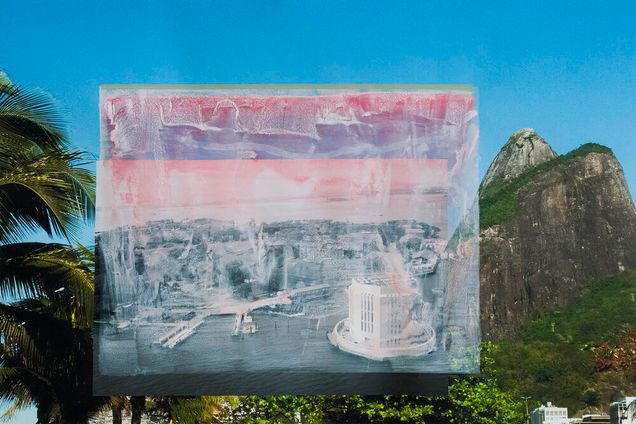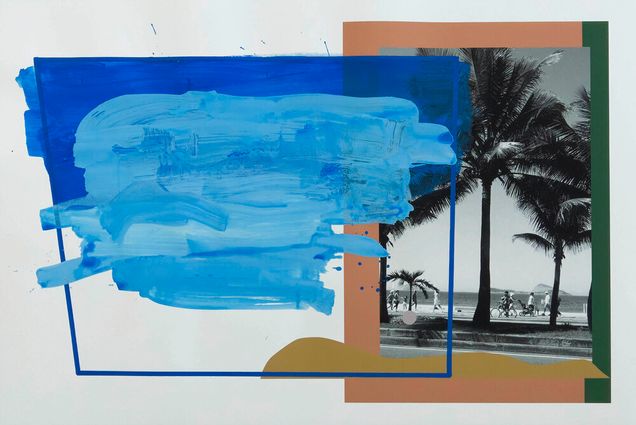at HOME by Alice Quaresma
Pablo’s Birthday, New York
September 17–October 25, 2020
by J. English Cook

In his elegiac ruminations in The Poetics of Space (1958), Gaston Bachelard describes the intimate, sensuous associations that we often apply to the notion of home. Unexpectedly, his prose foreshadowed the confrontations between emotional and architectural interiority in our contemporary pandemic times. “Memories of the outside world,” he writes, “will never have the same tonality as those of home and, by recalling these memories, we add to our store of dreams. . . .”1 Bachelard’s slippage between factual recollections and poetry, physical space and dreams is at the forefront of at HOME, a solo exhibition of photography-based, mixed media works by Alice Quaresma at the New York City gallery Pablo’s Birthday.2

Conceived during the COVID-19 lockdown, the show revealed Quaresma’s own ruminations on the state of physically isolated living. “As a good traveler,” she writes, “whenever I cannot physically be somewhere, I travel in my mind, I use my imagination.”3 Drawing upon her memories of living in both New York and Rio de Janeiro, her hometown, the exhibition conveyed the emotional connections that accrue from fluid experiences of “home.” In light of travel restrictions and confined to her home-cum-studio in Brooklyn, Quaresma mined her photographic collection from both cities, colorfully collaging, transposing, or collating her images into an effervescent curatorial and artistic statement (fig. 1). Through experimental combinations of texture, shape, and figuration; pigments and photography; and the play between individual works and holistic environments, Quaresma creates a convivial atmosphere in which two-dimensional gallery objects evoke the experience of three-dimensional exterior spaces.

In order to create works from home that speak to a deeper sense of feeling at home—or the loss thereof—Quaresma applies a wide range of strategies. The titles of individual works like Faraway, Disconnected, and Adrenaline,for example, convey different affective associations with the aerial and landscape views of her respective cities, while works like Dreaming with Eyes Open and Somewhere in My Mind gesture to a more introspective take on the intersections between material and emotive space. Clash, in particular, visualizes the dialectics at the heart of at HOME: a photographic print of New York City’s coastline, faded in shades of grey, has been doused in painterly pink and white gouache (fig. 2). Taped onto a vivid reproduction of Rio’s Two Brothers peaks (Morro Dois Irmãos), the subdued, mottled tones of New York’s coast—under lockdown at the time of Quaresma’s making—renders the city faded and hazily distant.4 Despite being this work’s place of origin, the Big Apple pales in comparison to the flushed saturation of Brazil’s luscious landscape, geographically distant but imaginatively close. New York’s waterfront, for example, is pictured at a remove from above, in contrast to the more proximate, eye-level view of Rio’s shores. Additionally, Quaresma’s use of broad, messy strokes and visible adhesive contrasts with the balance of clean geometric shapes, juxtaposing her artistic process against formal composition. Her indexical marks, however, slip slightly over the black-and-white photograph’s right-hand edge, briefly submerging both figurative realms within the translucent windowpane of painterly marks. Quaresma’s embodied memories, in this sense, become syntactically intertwined.
Introspective applies a similar approach, pairing a close-up of vibrant, lime-green fruit with a distant, black-and-white view of The Eldorado residence overlooking Central Park (fig. 3). A combination of acrylic paint, color pencil, and stickered-over photographic print, this work frames, accents, and punctuates its subjects, establishing an emotive syntax within a visual, visceral grammar.

This method of using contrasting representational styles to convey embodied experience belongs to a longstanding, international tradition of twentieth-century abstraction.5 Like many of these artists, Quaresma contrasts distinctive brushwork with structured geometries to communicate a sensual engagement with her canvas. Her gestural color gradients, punctuation-like shapes, and cut-out stylings connect the viewer, indexically, to her emotive associations at the time of making, as seen in the interplay of brush strokes and bold lines in Summer Days (fig. 4). Part of what distinguishes Quaresma’s work in the twenty-first century, however, is the application of these earlier practices to photography, creating a poetic vocabulary that playfully and incisively reveals the medium’s oneiric attachment to the material world. As Bachelard would conclude, in describing the home: “we are never real historians, but always near poets.”6 By reflecting on themes of personal attachment, displacement, and imaginary travel while inside, Quaresma’s exhibition followed suit, functioning as a lively form of critique that pointed to an important stake of art and criticism in the time of COVID-19: opening up avenues for poetic catharsis within the interior spaces of our makeshift quarantine homes, wherever and whenever in the world they may be.
____________________
J. English Cook
J. English Cook is a writer, curator, and PhD candidate at the Institute of Fine Arts, New York University. Her research focuses on historical intersections between cinema, architecture, and philosophy, particularly as expressed in material adaptations of postwar phenomenology between France and Italy.
____________________
Footnotes
1. Gaston Bachelard, The Poetics of Space, trans. Maria Jolas (Boston, MA: Beacon Press, 1994), 6.
2. Alice Quaresma, “Press Release: at HOME,” (New York: Pablo’s Birthday, 2020).
3. Ibid.
4. In the exhibition’s press release, Quaresma explains that during lockdown, she “stopped traveling, and the only place [she] could explore was within [her] imagination,” Ibid.
5. In an interview conducted by the gallery, Quaresma referenced Lygia Pape, Lygia Clark, and Hélio Oiticica—members of Brazil’s Neo-Concrete Movement—as explicit references. Alice Quaresma, “Interview with Alice Quaresma,” interview by Clara Andrade Pereira, Pablo’s Birthday, New York, 2020.
6. Bachelard, The Poetics of Space, 6.